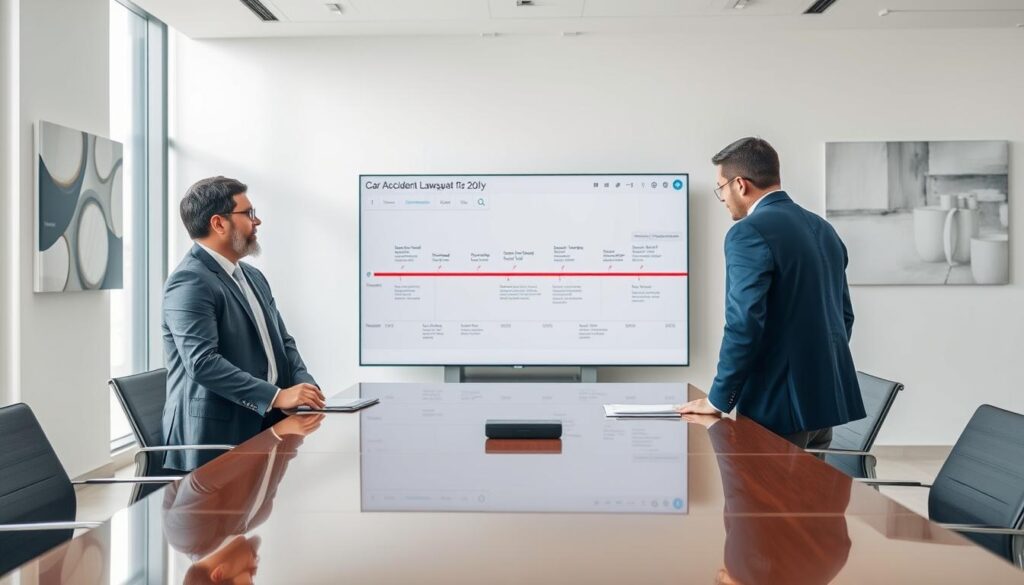Car Accident Lawsuit: What You Need to Know About Compensation

Being involved in a vehicle accident can be a traumatic experience, leaving you with physical injuries, emotional distress, and financial burdens. If you’ve been injured due to someone else’s negligence on the road, you may be entitled to compensation for your losses.
Understanding the process of a car accident lawsuit can be daunting, but it’s crucial for recovering the damages you deserve. When insurance claims are insufficient to cover your medical expenses and lost wages, a lawsuit may be your best option.
Navigating the legal process requires knowledge of what constitutes a valid case, the types of compensation available, and the factors that influence the timeline for resolving your case.
Key Takeaways
- Understanding the basics of a car accident lawsuit is crucial for recovering fair compensation.
- A lawsuit may be necessary when insurance claims fall short of covering your damages.
- The timeline for resolving a lawsuit varies depending on several factors, including injury severity.
- Knowing what constitutes a valid case is essential for a successful claim.
- Working with a lawyer can help maximize your compensation.
Understanding Car Accident Lawsuits
Being informed about car accident lawsuits can make a significant difference in how you handle the situation. When you’re involved in a vehicular collision, the legal implications can be complex and overwhelming. Understanding the basics of a car accident lawsuit is essential for navigating the legal system effectively.
A car accident lawsuit typically involves one party (the plaintiff) seeking compensation from another party (the defendant) for damages incurred due to the accident. In most cases, the injured person is suing because the defendant accidentally or intentionally caused them an injury.
What Constitutes a Valid Car Accident Claim
A valid car accident claim usually involves proving that the defendant was negligent or at fault, leading to the accident. This can include accident cases such as rear-end collisions, T-bone collisions, or head-on collisions, among others.
To have a valid claim, you typically need to demonstrate that the defendant owed you a duty of care, breached that duty, and caused your injuries as a result.
Common Types of Car Accident Cases
Various types of car accident cases can lead to lawsuits. Some common examples include:
- Rear-end collisions, often resulting from distracted driving or following too closely.
- T-bone or side-impact collisions, frequently occurring at intersections.
- Head-on collisions, which can result in severe injuries and fatalities.
- Multi-vehicle pileups, presenting challenges in determining fault.
- Cases involving commercial vehicles, which may include claims against both the driver and their employer.
- Rideshare accidents, introducing complexities regarding insurance coverage and liability.
Understanding these common types of cases can help you better navigate the legal process following a car accident.
When to Consider Filing a Car Accident Lawsuit
If you’ve been involved in a car accident, understanding when to file a lawsuit is crucial for securing the compensation you deserve. The aftermath of an accident can be overwhelming, especially when dealing with injuries and damages.
Knowing when to take legal action can significantly impact your ability to cover losses resulting from the car accident. It’s essential to consider the severity of your injuries and the extent of your damages when deciding whether to pursue a lawsuit.
After Insurance Claims Fall Short
One key indicator that it’s time to consider a lawsuit is when your insurance claim doesn’t cover all your expenses related to the accident. If your insurance payout is insufficient to address your damages, a lawsuit can help you seek additional compensation.
- Serious car accident injuries often result in substantial medical expenses that exceed insurance policy limits.
- A lawsuit can help ensure you receive fair compensation for your losses, including future medical care needs.
Serious Injuries and Long-Term Damages
If you’ve suffered injuries that result in long-term or permanent damagesinjuries, such as traumatic brain injuries or spinal cord damage, often warrant legal action to secure adequate compensation for future medical care, lost earning capacity, and diminished quality of life.
A lawsuit allows you to pursue compensation for non-economic damages like pain and suffering, which insurance companies often undervalue or ignore entirely.
Statute of Limitations for Car Accident Lawsuits
The statute of limitations for car accident lawsuits varies, and it’s essential to understand the specifics. This legal deadline dictates how long you have to file a lawsuit after a car accident. Missing this deadline can result in your case being dismissed, regardless of its merits.
To navigate the complexities of car accident lawsuits effectively, it’s crucial to be aware of the standard time limits and any exceptions that may apply to your case.
Standard Time Limits in the United States
In the United States, the statute of limitations for car accident lawsuits differs from state to state. Generally, you have between two to three years from the date of the accident to file a lawsuit. For instance, if you’re in a car accident on January 1, 2023, you typically have until January 1, 2025, or January 1, 2026, to file your claim, depending on your state’s laws.
It’s vital to consult with a legal professional to determine the exact statute of limitations in your jurisdiction. They can provide guidance based on the specifics of your case and ensure you don’t miss the filing deadline.
Exceptions That May Extend Your Filing Deadline
While the statute of limitations is a firm deadline in most cases, there are exceptions that may allow you to file a lawsuit even after the standard time limit has expired. These exceptions can significantly impact your case.
- The “discovery rule” may apply if your injuries weren’t immediately apparent after the accident. This rule can extend the statute of limitations until the date you discovered or should have reasonably discovered your injuries.
- If the at-fault driver leaves the state after the accident, the statute of limitations may be “tolled” or paused until they return.
- For victims who were mentally incapacitated due to their injuries, the statute of limitations may be tolled until they regain capacity. Consulting with a lawyer who understands the nuances of car accident cases can help you navigate these complexities.
Understanding these exceptions is crucial for ensuring you don’t miss your opportunity to seek compensation. If you’re unsure about how the statute of limitations applies to your case, seeking legal advice is the best course of action.
Types of Compensation Available in Car Accident Lawsuits
Car accident lawsuits often involve seeking compensation for a range of damages, from medical expenses to emotional distress. When you’re involved in a car accident, the financial impact can be significant, and understanding the types of compensation you’re entitled to is crucial.
Economic Damages
Economic damages are intended to compensate you for direct financial losses resulting from the accident. These can include medical bills, lost wages, and property damage. By quantifying these expenses, you can seek fair compensation for your economic losses.
Non-Economic Damages
Non-economic damages address the intangible effects of an accident, such as pain and suffering, emotional distress, and loss of enjoyment of life. While these damages are more subjective, they are equally important in determining the overall compensation you may receive.
Punitive Damages
In cases where the fault party’s behavior was particularly egregious, you may be eligible for punitive damages. These are not meant to compensate you for your losses but rather to punish the at-fault party for their actions. Examples include drunk driving or extreme recklessness. It’s worth noting that punitive damages are subject to specific legal standards and caps in many jurisdictions.
Punitive damages can be complex to claim, as they require “clear and convincing evidence” of malicious, willful, or reckless behavior. However, when awarded, they can significantly increase the total compensation received.
Gathering Evidence for Your Car Accident Lawsuit
To build a robust car accident lawsuit, it’s essential to collect and document evidence that proves the other party’s liability and the extent of your damages. As your lawyer begins to perform legal research on your case, gathering evidence will help them build the strongest possible argument for why the other driver is responsible and why you’re entitled to full compensation for your losses.
Essential Documentation to Collect
Collecting the right documentation is critical to supporting your car accident claim. You should gather:
- Police reports and accident scene photographs
- Medical records and bills related to your injuries
- Witness statements and contact information
- Records of lost wages and earning capacity
- Any other relevant documentation that illustrates the impact of the accident on your life
Witness Statements and Expert Testimony
In addition to documentation, witness statements and expert testimony can provide valuable information to support your case. Witness statements from people who saw the accident can offer crucial third-party perspectives on how the collision occurred. Consider the following types of witnesses:
- Witnesses who saw the accident happen
- Expert witnesses, such as accident reconstruction specialists
- Medical experts who can testify about the nature and extent of your injuries
- Economic experts who can calculate complex damages like future medical expenses and lost earning capacity
By gathering comprehensive evidence and working with your lawyer, you can build a strong car accident lawsuit that demonstrates the other party’s liability and supports your claim for fair compensation.
The Car Accident Lawsuit Process

The car accident lawsuit process can be complex, but understanding its stages can help you prepare for what’s ahead. When you file a lawsuit after a car accident, you initiate a legal process that involves several key phases.
Initial Filing and Response
The process begins with the initial filing of your lawsuit. This involves submitting a complaint to the court, which outlines your case against the defendant. The defendant is then served with the lawsuit and must respond within a specified timeframe. Your attorney will guide you through this process, ensuring that all necessary documents are filed correctly and on time.
Discovery Phase
After the initial filing and response, the case proceeds to the discovery phase. During this stage, both parties exchange information and evidence related to the case. This can include depositions, interrogatories, and requests for documents. The discovery phase is crucial as it allows both sides to gather the information needed to build their arguments.
Pre-Trial Negotiations
As the case progresses, pre-trial negotiations become a significant focus. Settlement negotiations often continue throughout the pretrial phase. If the parties cannot come to an agreement, the judge may order mediation. In mediation, a neutral third party helps facilitate a discussion between you and the defendant to reach a settlement. Key aspects of pre-trial negotiations include:
- Pre-trial negotiations intensifying after discovery is complete
- Settlement conferences scheduled by the court
- Mediation involving a neutral third party
- Your attorney presenting demand packages with evidence
- Most car accident lawsuits settling during this phase
For more detailed information on the trial process, you can visit https://justinmintonlaw.com/auto-accident-trial-process/.
Settlement vs. Trial: Understanding Your Options
If you’ve been in a car accident, knowing the difference between settling your case and taking it to trial can significantly impact your compensation. When an insurance company refuses to offer a fair amount for your injuries, you may need to consider other options.
There are situations where the insurance company disputes liability for the car accident or challenges the severity of your injuries. In such cases, your attorney may advise filing a lawsuit.
Advantages of Settling Out of Court
Settling your car accident case out of court can have several benefits. It often results in a faster resolution and can reduce the stress associated with going to trial. Additionally, settlements are typically less costly for all parties involved.
Some key advantages of settling include:
- Avoiding the uncertainty of a trial verdict
- Reducing legal costs and fees
- Minimizing the time spent on litigation
- Having more control over the outcome
When a Trial is the Better Option
There are instances where going to trial is the more suitable choice. This is often the case when the insurance company refuses to offer a fair settlement amount that adequately compensates you for your injuries and losses.
Some scenarios where going to trial might be necessary include:
- When the insurance company disputes liability and you have strong evidence to support your claim
- In cases involving severe injuries or significant damages
- If your case involves important legal principles that could set a precedent
- When the insurance company is acting in bad faith or using delay tactics
Ultimately, the decision to settle or go to trial should be made in consultation with your attorney, who can provide guidance based on the specifics of your case and the potential outcomes of each option.
Working with a Car Accident Lawyer

After a car accident, partnering with the right lawyer can make a substantial difference in your compensation. A skilled car accident lawyer can guide you through the complex legal process, ensuring you receive the compensation you deserve.
How Attorneys Can Strengthen Your Case
An experienced attorney can significantly strengthen your car accident case by gathering essential evidence, negotiating with insurance companies, and representing you in court if necessary. They understand the tactics insurance companies use to minimize payouts and can counter these effectively.
Understanding Attorney Fees and Contingency Arrangements
Most car accident lawyers work on a contingency fee basis, meaning they only get paid if you win your case through settlement or trial verdict. This arrangement aligns your attorney’s interests with yours, as their fee is a percentage of your recovery. Typically, contingency fees range from 33% to 40% of your recovery.
- Most car accident lawyers work on a contingency fee basis, meaning they only get paid if you win your case through settlement or trial verdict.
- Contingency fees typically range from 33% to 40% of your recovery, with the percentage sometimes increasing if the case proceeds to trial.
- This fee arrangement allows accident victims to access quality legal representation regardless of their financial situation.
Special Considerations in Car Accident Lawsuits

When it comes to car accident lawsuits, certain situations demand unique attention. These cases often involve complex scenarios that require a deeper understanding of the law and its applications.
Dealing with Government Vehicles
If you’re involved in an accident with a government vehicle, the process can be more complicated due to sovereign immunity laws. These laws can limit the ability to sue government entities, making it crucial to understand the specific regulations that apply to your case. Consulting with a lawyer who has experience in handling such cases is essential.
Uninsured or Underinsured Drivers
Accidents involving uninsured or underinsured drivers present unique challenges. Your own insurance coverage, specifically uninsured/underinsured motorist (UM/UIM) coverage, becomes vital in these situations. For more information on navigating such cases, you can refer to resources like car accident lawsuit guides. Additionally, understanding the role of third-party liability can be beneficial.
Conclusion: Protecting Your Rights After a Car Accident
The aftermath of a car accident involves not just physical recovery but also navigating a complex legal landscape to claim your rightful compensation. To protect your legal rights, it’s crucial to take prompt action and understand the car accident lawsuit process. This empowers you to make informed decisions at each stage.
By gathering strong evidence and working with an experienced car accident attorney, you can navigate the legal system effectively. Remember, insurance companies prioritize their profits over your recovery, making it essential to approach settlement offers with caution and proper legal guidance.
